Healthcare Industry Reports
Healthcare organizations across the globe face difficult decisions in selecting partners and solutions that will produce the best outcomes. Our team of researchers is committed to helping you answer the most pressing industry questions using insights that come directly from your peers.

Features
The KLAS research team publishes 55+ insight-driven reports per year, covering the most pressing questions facing healthcare technology today. The executive summaries of our reports are available to healthcare providers and payers at no cost, in exchange for a willingness to share their experiences with KLAS. Each report contains the following core features:
Easy to digest
Our goal is to make engaging with our data fast and easy for you. All of our key report findings are in short, two-page executive summaries with what you need to know at a glance. For those who need in-depth background information, we offer our extensive write-ups with detailed insights, demographics, report methodology, and custom commentary through our Partner-level memberships.
Key findings and analysis from in-depth peer interviews
Through the lens of provider experiences, the KLAS team evaluates the current success of healthcare technologies and services and projects future trends. Along with this analysis, KLAS reports include frameworks that help to make sense of complexities in care delivery and benchmark the vendors' positions to help.
Advice and insights from actual healthcare professionals
Each report is filled with recommendations and best practices from actual customers that KLAS interviews. We carefully validate that each and every product review was given by an actual person directly involved with the solution being measured, so you can trust the insights.
Recently Published Reports
Check out the latest industry trends

When making a core HIT purchasing decision, ambulatory healthcare organizations must take into account how prospective partners deliver across a variety of key technology areas beyond core EHR and PM solutions. This Veradigm “complete look” provides a high-level analysis of the key IT components that make up Veradigm’s comprehensive suite. (Other reports in the series do the same for .)

When making a core HIT purchasing decision, ambulatory healthcare organizations must take into account how prospective partners deliver across a variety of key technology areas beyond core EHR and PM solutions. This NextGen Healthcare “complete look” provides a high-level analysis of the key IT components that make up NextGen Healthcare’s comprehensive suite. (Other reports in the series do the same for .)

When making a core HIT purchasing decision, ambulatory healthcare organizations must take into account how prospective partners deliver across a variety of key technology areas beyond core EHR and PM solutions. This Greenway Health “complete look” provides a high-level analysis of the key IT components that make up Greenway Health’s comprehensive suite. (Other reports in the series do the same for .)

When making a core HIT purchasing decision, ambulatory healthcare organizations must take into account how prospective partners deliver across a variety of key technology areas beyond core EHR and PM solutions. This eClinicalWorks “complete look” provides a high-level analysis of the key IT components that make up eClinicalWorks’s comprehensive suite. (Other reports in the series do the same for .)

When making a core HIT purchasing decision, ambulatory healthcare organizations must take into account how prospective partners deliver across a variety of key technology areas beyond core EHR and PM solutions. This athenahealth “complete look” provides a high-level analysis of the key IT components that make up athenahealth’s comprehensive suite. (Other reports in the series do the same for .)
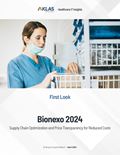
As healthcare organizations face rising operational costs, they are looking to enterprise resource planning solutions to optimize supply chains and minimize expenses. In the Brazilian market, Bionexo seeks to meet provider needs, be a source of transparency and reliable information, and facilitate customer purchases from suppliers. This report looks at the satisfaction and functionality adoption of Bionexo customers at several Brazilian healthcare organizations.

To personalize healthcare and prioritize patient preferences, provider organizations often use customer relationship management (CRM) tools, which can effectively organize and present the details of a patient population. Recently, the CRM market has shifted—vendors have entered the market, sensing the opportunity to address organizations’ growing interest in personalizing care and improving their management of patient data, and some of these newer entrants are now on par with seasoned players. This report examines customers’ experiences with three vendors to see how well they partner with customers and deliver strong technology.

The recent rise of generative AI in clinical documentation has led many healthcare organizations to look at ambient speech products to decrease non-clinical work and burnout for physicians. Suki leverages machine learning and large language models to power their solution’s voice-enabled, fully automated generative AI. The Suki Assistant solution generates clinical notes in real time and provides capabilities such as audibility features and code suggestions. This report examines the experience and satisfaction of Suki customers, including healthcare leaders and physician users.

Ambient speech AI technology is top of mind for many healthcare organizations as they seek ways to improve physician efficiencies and well-being. Using machine learning and large language models, Abridge’s voice-enabled, fully automated generative AI solution generates clinical and patient notes in real time. The Abridge product aims to increase trust and impact through code suggestions, multilingual capabilities, and mapping of AI content to audio/transcript evidence. This report explores the experience and satisfaction of Abridge customers, including healthcare leaders and physician users.

Healthcare organizations are very focused on enterprise imaging (EI) advancement. Two-thirds of the organizations interviewed by KLAS about future EI plans are likely to expand their VNA image storage or extend their universal viewer (UV) to additional service lines in the next two years. Organizations are also increasingly taking advantage of promising new technology like artificial intelligence (AI) and the cloud. Meanwhile, both vendors and healthcare organizations face budget and staffing shortages and rapidly changing market needs. This report (1) examines how vendors stack up in meeting clients’ ever-growing EI needs and (2) shares a broader analysis of progress in the EI market.

With the rapid rise in value-based care contracts and emphasis on patient population health, healthcare provider organizations are looking for insights into specific populations and metrics to manage outcomes and coordinate care. COPE Health Solutions seeks to meet this need by providing analytics and visualizations of population health data through the Analytics for Risk Contracting (ARC) solution. This report takes a first look at customer satisfaction and key functionality adoption among ARC customers.

Healthcare organizations are continually expanding their use of smart devices, but their unique needs for durability, healthcare-centric workflows, and low costs can present challenges for both users and the organizations purchasing the devices. While many healthcare organizations opt for BYOD programs in specific departments, several are adopting shared smart device programs. Based on interviews from 80 healthcare organizations using such programs,

China-based iMEDWAY offers a solution called iMedical—an integrated, customizable platform intended to help provider organizations store medical data and coordinate patient care. This report—KLAS’ first to offer insights on iMEDWAY—looks at the satisfaction and key outcomes of customers using iMedical.

Two critical components of comprehensive patient care—healthcare education and patient engagement—empower patients to make informed health decisions and better prepare for treatment. Effectively providing education and measuring patients’ usage is essential for healthcare organizations, especially in improving quality, safety, and the patient experience. Mytonomy Cloud for Healthcare is a patient education and engagement platform with original and tailored clinical content that aims to improve patients’ education experience. This report examines feedback from several Mytonomy customers.

As healthcare organizations face tight labor markets, constrained budgets, staff burnout, and government regulations, their priorities and investment plans for healthcare IT are shifting. To understand these issues and resulting priorities, KLAS interviewed 219 healthcare organizations in 42 countries/territories about their priorities for IT investments, plans for leveraging the cloud, and consideration of consulting firms for future engagements. This report also examines how priorities have changed since KLAS’ to learn more about US organizations’ investment priorities.)

The use of artificial intelligence (AI) in healthcare is rapidly evolving. More healthcare organizations are adopting data science platforms and other AI solutions to help alleviate the challenges of today’s environment, with a particular focus on increasing operational efficiency. Based on the feedback of both payer and provider organizations, this report examines the clinical, financial, and operational use cases for which AI is being adopted as well as the outcomes being achieved.

Due to staffing shortages and rising costs, healthcare organizations are increasingly looking to outsourced managed services firms to relieve the burden of hiring and maintaining IT staff—enabling organizations to reallocate and better utilize their in-house resources. This report—the first in a series to focus on managed IT services—examines which firms consistently deliver quality application management services (AMS) and help desk services to healthcare provider and payer organizations; it also shares insights into the managed IT services market, including the pain points driving organizations to adopt and expand use of IT outsourcing. KLAS intends to publish reports on the other two managed IT services verticals later in 2024.

Healthcare organizations continue to face challenges with getting reimbursements, due in part to large volumes of complex medical claim denials issued by payer organizations. To access expertise in managing the appeals process, many healthcare organizations are engaging denials management services firms, who utilize multidisciplinary teams (e.g., legal, clinical, coding) to review accounts and submit appeals. This report—KLAS’ first on denials management services—examines which firms consistently deliver strong execution, expected overturn rates, expertise, and partnership in denials prevention.
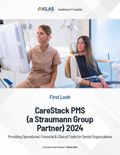
Straumann Group has partnered with CareStack to launch CareStack PMS, a consolidated dental organization management solution that provides the operational, financial, and clinical tools a dental practice needs to succeed. This report presents the feedback of several customers and examines their satisfaction and adoption of key solution functionality.

Drug shortages present problems for healthcare organizations as they endeavor to provide the best care possible. Unless organizations have proper processes in place, significant drug shortages can have cascading negative impacts across the care continuum. LogicStream Health’s Shortage Navigator aims to deliver all the tools providers need to be prepared for medication shortages. This report examines the experiences of several Shortage Navigator customers.

Many patients’ healthcare experiences begin with an interaction in the front office. Therefore, a streamlined front office experience is beneficial to both patients and healthcare staff. Simple Interact aims to provide the tools provider organizations need through the Front Office Automation platform, which works to improve workflows, reduce staff needs, and increase patient acquisition. This report examines the experiences of several Simple Interact customers.

Provider organizations are seeking communication tools that enable interoperability with a diverse set of solutions, ultimately ensuring the right clinician gets the right information at the right time. This report looks at the interoperability capabilities of communication solutions through the lens of deeply adopting provider organizations and whether they are able to break down silos between different departments and organizations through enhanced integration. These experiences are not typical of all customers and represent the hard work of vendors and providers deeply engaged in interoperability.

As health plans continually look to reduce costs and improve outcomes for their members, they are utilizing data analytics platforms to bring better visibility to their decisions. This vendor guide is intended to provide a simple starting point for health plans investigating data analytics platforms. The guide focuses on vendors that (1) provide a platform approach to their data analytics solutions, (2) operate across multiple US regions, and (3) provide a variety of use cases. All such vendors known to KLAS as of January 2024 are included in this guide.
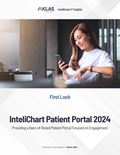
Although most EHR vendors offer a patient portal, the functionality does not always meet customer needs. InteliChart offers an alternative option through their patient portal, aiming to provide an all-in-one patient engagement platform that fully integrates with any EHR and includes automated tools such as self-scheduling and integrated forms. This report examines the experiences of customers using the InteliChart Patient Portal.

In the dynamic market of ambulatory care, practices are continually evaluating their options for EHR and PM solutions—which vendors are top of mind fluctuates as regulations change, technology advances, and vendor reputations evolve. For this report, KLAS spoke to over 200 ambulatory practices to examine which ambulatory EHR/PM vendors have the most mindshare for future potential decisions and which vendors are being considered or chosen in actual decisions.

In November 2023, KLAS hosted the third Patient & Consumer Innovation (PCI) Summit in Salt Lake City, Utah. Thought leaders from healthcare delivery organizations and HIT companies were in attendance, along with—most importantly—patient representatives. All attendees came together to discuss the transformation necessary to more fully involve patients in healthcare and measure what matters most to healthcare organizations. Drawing on responses from both a pre-summit survey and small-group discussions at the summit, this paper highlights KLAS’ updated patient engagement framework and shares best practices for patient communication and patient self-scheduling.

Many healthcare organizations in Canada have been using their PACS for years. Since the outbreak of the COVID-19 pandemic, KLAS has seen potential-replacement rates for Canada PACS solutions increase to a historic high, where more than one-third of interviewed organizations are actively looking to replace their PACS. This report examines vendors’ performance and the customer experience in Canada to help organizations understand the strengths and weaknesses of available options in the market.

Amid changing regulations from entities like the American Academy of Pediatrics and HIPAA, pediatric clinics’ functionality needs are increasing and becoming more specific. Most ambulatory pediatric practices are small organizations with limited budgets, and they have to prioritize functionalities that are most important and forgo others to stay within budget. In addition to established pediatric-specific vendors, broad-specialty vendors are addressing this challenge by developing pediatric-specific EHRs or adapting existing platforms to cater to customer needs. Following , this report examines how well pediatric-specific and broad-specialty vendors meet the unique customer needs of this niche market.

As the digital landscape grows in healthcare and other industries, patients are expecting more seamless and convenient access to healthcare and therefore report that self-scheduling is one of their by offering patient self-scheduling functionality to both increase patient convenience and reduce staff burden. This report focuses on five standalone patient self-scheduling solutions to understand their ease of use, why they were chosen over other types of solutions (e.g., EHR functionality), and whether they are worth the money. Additional insights about the broader patient self-scheduling market are also included.

Both patients and provider organizations want solutions that simplify the often confusing, inefficient process of writing, filling, and paying for prescribed medications. Surescripts’ Real-Time Prescription Benefit solution streamlines the prescription process by connecting prescribers with relevant information on patient insurance coverage, medication costs, and alternative medications. This report provides a first look at provider customers’ experiences, outcomes, and satisfaction with this solution.

For revenue cycle leaders, it is critical to stay on top of trends in payer interactions and identify opportunities to address billing and collection inefficiencies. All healthcare organizations use RCM analytics solutions—their EHR offering, a third-party solution, or a combination of both—to comprehensively understand their RCM practices and glean actionable insights that can optimize revenue and inform decisions. Drawing from the experience of organizations using third-party tools that ingest data from multiple disparate sources, this report provides insights into the performance of three different solutions.

Over the last few years, the home health market has undergone extensive changes following mergers and acquisitions, fluctuating regulatory requirements, and shifts in the workforce. As a result, user frustration around home health solutions has increased, and home health agencies have sought greater collaboration, development, and automation from their vendors, with some customers even reconsidering their current investments. Through a look at current market share, recent purchase decisions, and customer satisfaction, this report examines which home health vendors are best meeting provider needs, developing functionality, and driving value for customers.
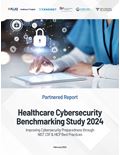
With cyberattacks on the rise, having a strong cybersecurity strategy is a must for healthcare organizations, especially as they face post-pandemic resource constraints and staffing shortages. Many are protecting their data by adopting and implementing cybersecurity frameworks and best practices, such as the on the status of healthcare cybersecurity preparedness. It also examines the effect of governance and resource investment on cybersecurity preparedness and insurance premiums. Data for this report comes from 58 respondents (54 payer or provider organizations and 4 healthcare vendors) who were interviewed September–December 2023.

Over the last five years, the Middle East and Africa healthcare IT markets have expanded and evolved. The Middle East has seen consistent energy around EHR investment and digital transformation, with 10–15 purchase decisions being made annually. Energy in Africa has fluctuated year over year, impacted by some very large regional purchase decisions. When selecting an EHR vendor partner for the digital journey, organizations almost always consider other clinical, administrative, and financial functionalities in addition to the core EHR capabilities the vendor provides. This report both provides an update on EHR vendor performance and market share and offers KLAS’ first holistic look at EHR vendors’ broader portfolios in the Middle East and Africa, specifically highlighting the adoption and performance of ancillary EHR modules.

Across the healthcare industry, executives are grappling with myriad challenges and high-stakes decisions that will affect the trajectory of their organizations. Many are turning to management consulting firms for help enhancing operations and improving performance long term. KLAS interviewed 163 healthcare leaders from March 2023 to December 2023 to gather their perceptions on which challenges are most pressing, what consideration factors should be used to evaluate firms, and which firms are seen as best suited to help. KLAS intends to use these findings to measure the service offerings and firms that have the most mindshare in healthcare.

Staff scheduling in healthcare has a unique set of challenges that can be exacerbated by provider volume and manual processes for clinical workflow management. These challenges can lead to problematic patient care and poor provider and staff experiences. The TeamBuilder solution, built specifically for ambulatory facilities, is intended to alleviate organizational pain points around staff scheduling by assessing the needs of day-to-day operations and offering predictive staff scheduling. It aims to increase operational efficiency by taking on the burden of creating and managing schedules. This case study examines feedback from three respondents at one organization using TeamBuilder.

Especially outside the US, many organizations still rely on paper records for their processes, partly due to the substantial time and resources required to transition to digital processes. Vodafone Egypt offers services to help healthcare organizations adopt and maintain digital workflows, provided through the University Hospitals in Egypt. Vodafone Egypt aims to remove a large portion of the transition burden from providers by communicating with vendor partners and helping with EHR training and support. This case study examines early feedback from five respondents at one organization using Vodafone Egypt’s services.

Apprio was founded to help organizations solve key revenue cycle problems and has since evolved to provide automation solutions that help decrease costs and improve patient and employee satisfaction in the healthcare industry. The Apprio offering uses automation bots to reduce labor costs and improve organizational efficiency by automating repetitive workflows such as checking claims statuses and VA authorizations. This case study examines the experiences of several respondents from one organization using Apprio.

Consumerism and patient-centric tools are an increasing focus in healthcare—, and they continue to be important as healthcare organizations work toward increased efficiency and cost savings. While all measured vendors have room to improve functionality (e.g., two-way patient texting, patient satisfaction surveys), this report validates the breadth and depth of patient intake management solutions, identifies the outcomes these solutions drive, and examines the respective merits of third-party and EHR solutions.

KLAS’ report found that investment in digital health is among healthcare organizations’ top three priorities across global regions. Patient engagement, alongside virtual visit technology and remote patient monitoring, is one of the key pillars of digital health. For this report, KLAS interviewed healthcare leaders from 155 organizations across 39 countries and territories around the world, and these leaders shared their current and future patient engagement priorities, their adoption of various patient engagement technologies, and what vendors they are using or considering.

The emergency department can be a chaotic and stressful environment that leaves patients feeling forgotten, but technological solutions can improve the patient experience without adding to the provider workload. Vital‘s ERAdvisor provides personalized tools and updates from check-in onward, thereby increasing patient engagement throughout the emergency department. This report examines the experiences of several ERAdvisor customers.

In the face of tighter staffing budgets and ever-changing requirements from payers, ambulatory provider organizations are increasingly relying on revenue cycle management (RCM) services firms—both EHR associated and EHR agnostic—to fill resource gaps and help develop processes that will maximize reimbursements. Further, organizations want a firm that will effectively own the claims process and be a true partner. Building on the report, this report examines both EHR-associated and EHR-agnostic services firms and shares how well they are meeting clients’ revenue cycle needs. Of note, many aspects of clients’ experiences are similar, whether they use an EHR-associated or an EHR-agnostic firm.

Provider organizations are facing intensifying revenue cycle complexity, payer relations, cost pressures, and staffing shortages, along with the resulting loss of resources and expertise. To find relief from some of these pressures, many are seeking outsourced extended business office services (EBOS) offered by firms that can execute revenue cycle management (RCM) work more economically and with greater efficiency than organizations can in-house. To share insights into a shifting market, this report provides (1) an update on client satisfaction and adoption and (2) a look into provider plans for outsourced revenue cycle services and satisfaction with offshore resources.

To combat a challenging financial market, ophthalmology practices are seeking EHR and practice management solutions that provide efficiencies, robust functionality, and strong ophthalmology-specific workflows. Many of these clinics also highly value their vendor relationships, where strong support and training enable the most effective use of the product and better outcomes for their practices. As a follow-up to , this report examines the dynamics of the ophthalmology EHR and practice management market by comparing some of the leading solutions in the market today.
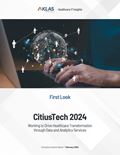
CitiusTech offers packaged solutions to address a range of healthcare challenges. The firm’s data and analytics services help both payers and provider organizations modernize their data and analytics. This helps enhance clinical decision support and drive strategy and healthcare transformation while working to achieve cost effectiveness and the best outcomes for members, patients, and the community. This report examines the client experience with CitiusTech’s data and analytics services.
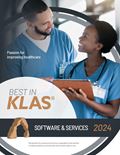
The Best in KLAS report recognizes software and services companies who excel in helping healthcare professionals improve patient care. All rankings are a direct result of the feedback of thousands of providers over the last year. A Best in KLAS award signifies to the healthcare IT industry the commitment and partnership that the top vendors should provide. Read the report to see the top-rated medical software and services for 2024.

The Best in KLAS award is given to vendors to recognize their outstanding efforts to help healthcare professionals deliver better patient care. Global awards are given in the following software market segments: (1) acute care EHR, (2) digital pathology, (3) PACS, (4) shared care records/HIE, and (5) virtual conferencing platforms.
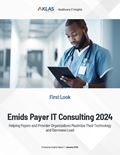
Payers and provider organizations are under increased pressure to maximize technology, decrease load, and deliver better care. Emids works to meet these current market needs through their payer IT consulting services, which include implementation services, managed services, and managed capacity to help drive needed outcomes like optimized implementations, decreased provider load, and improved overall process efficiency. This report offers a first look at client experiences with Emids’ payer IT consulting services.

Managing medication shortages is a complex yet important part of a pharmacy leader’s work. Without proper tools in place, it can be prohibitively difficult to navigate shortage workflows and use data effectively. OrbitalRX’s solution aims to automate shortage management and give pharmacists confidence in their workflow. This report examines the experiences of several OrbitalRX customers.

Simple Fractal aims to solve critical healthcare issues by automating complex end-to-end processes. Their custom and turnkey bot solutions help improve organizational efficiency, accuracy, and provider satisfaction while decreasing staff workloads and organization expenses. Simple Fractal’s digital workforce solutions span from initial business analysis, process discovery, and bot development to deployment and continuous operational support. This report offers a first look at customers’ experiences with Simple Fractal.

KLAS conducts thousands of interviews with provider and payer organizations each year to better understand their experience with their healthcare IT (HCIT) vendors. However, not all vendors are measured by KLAS today—some vendors have very small customer bases and others work in market segments outside KLAS' current focus. To gain insights into vendors we might not currently measure, KLAS asks interviewed organizations to share the most innovative or potentially disruptive HCIT vendors they have seen or heard about recently. Representing the feedback of 52 healthcare professionals and data from KLAS' website analytics, this report examines the emerging HCIT vendors and market segments that are top of mind for healthcare organizations and that are not currently measured by KLAS. In total, this report indexes 66 vendors across high-interest markets.

Healthcare organizations are under continual pressure from government-mandated laws to move away from manual workflows toward automation. This shift, coupled with software consolidation, aims to increase provider efficiency, and organizations are looking for products that meet their needs. Lean Business Services’ Raqeem platform is intended to help organizations improve efficiency and connectivity. This report shares customer experiences with the platform.

The US healthcare revenue cycle is inefficient and problematic. SparkChange addresses current key market needs by streamlining revenue cycle processes via database-level automations. These automations simplify complexities and minimize required tasks to ensure timely payments, allowing healthcare organizations to focus on what matters most—patient care. SparkChange aims to create sustainable performance improvements and provide lasting solutions, and this report offers a first look at customer experiences with the vendor’s solution.

Speed and accuracy are of the utmost importance during code blue events, but the tense nature of these events can rattle all healthcare professionals, even experienced ones. Redivus Health’s solution for cardiac arrest resuscitation aims to remove as many variables from code blue events as possible and act as a digital guide for patient care that reliably manages code blue events and reduces medical errors. This report examines customer experiences with the Redivus Health Code Blue solution.

Across the industry, provider organizations are feeling pressure from staffing shortages, payer challenges, shrinking margins, and ever-changing regulations. To ease these challenges, vendors are working to create end-to-end platforms that bridge all revenue cycle offerings, and they claim these platforms will increase operational efficiencies and reduce costs. For this report, KLAS spoke to provider organizations who have deeply adopted a vendor’s enterprise revenue cycle management offerings to get a snapshot of current customer satisfaction and examine the benefits and challenges of platform adoption.

Amid current economic challenges, healthcare organizations are contracting with debt collection services firms (often multiple at a time) to ensure financial stability, leverage specialized expertise, and comply with complex regulations. These firms possess the resources and knowledge to efficiently and ethically recover unpaid medical bills—supporting positive patient relationships and saving time for health systems so they can focus on providing quality care. In a market where most firms perform highly, this report—KLAS’ first on debt collection services—examines which firms provide strong technology, foster partnerships, and drive outcomes across organization sizes.

Payer organizations are under increasing pressure to maintain regulatory compliance and ensure strong data security at a low cost; thus, they are seeking payer IT consulting firms for help with advisory services, change management, implementations, and managed services. This report—KLAS’ first in this area—defines the broad ecosystem of payer IT consulting services and examines the market through firm-reported capability sets, validations, and performance data.

Across multiple industries, interest in generative AI is spiking, especially as more easy-to-access solutions enter the market. Unsurprisingly, healthcare organizations are among those interested in generative AI’s potential; however, many have concerns about its reliability and security and want to understand its true capabilities amid all the buzz. To explore some of these questions and concerns, this report—KLAS’ first to focus on generative AI—draws from the perspectives of 66 healthcare executives, sharing their current adoption, future plans, and current challenges regarding generative AI. KLAS intends to publish further general AI insights with the Center for Connected Medicine (CCM) in early 2024.

As healthcare organizations actively work to enhance clinical, financial, and operational outcomes, optimizing their data and analytics strategies will be imperative to success. In a landscape abundant with data (much of which lacks actionable insights), this report examines data and analytics services—KLAS’ first report on the market—with a focus on (1) outlining a framework for these services and (2) evaluating firms’ offerings and performance. Data for this report is based on feedback from 55 client organizations interviewed between March 2022 and September 2023.

The PACS market is in flux—about one in five organizations interviewed by KLAS in the last two years is planning to replace their PACS, and more report they would replace their system if given the opportunity. This market shift is driven largely by organizations (1) replacing aging/legacy technology with go-forward platforms, (2) consolidating platforms, and (3) continuing to move toward unified enterprise imaging strategies. Organizations replacing their PACS are seeking vendor partners with a vision for the future and a strong commitment to innovation. This report examines 90 recent PACS purchase decisions validated by KLAS between September 2021 and September 2023 to understand why certain vendors are being considered, selected, and replaced in this dynamic market.

Payer organizations are always looking to improve their payment and claims accuracy, and payment integrity initiatives play a large role in that endeavor. Because the work required to create and improve these initiatives is not always feasible internally, payers often use vendor solutions. EXL offers a modular approach to payment integrity that aims to provide deeper insights to payers through transparency and accessibility. This report offers a first look at the experiences of organizations using EXL’s payment integrity solutions.

In September 2023, KLAS hosted the seventh annual Digital Health Investment Symposium (DHIS)—about 200 executive thought leaders and representatives from healthcare organizations, HIT companies, and investment firms attended this strategic retreat to collaborate on important healthcare developments, with a specific focus on the tradeoffs between platforms and point solutions in the healthcare technology stack. This event overview shares insights from the event’s small-group discussions, especially highlighting the pressing challenges of the healthcare technology stack, staffing shortages, and AI.

The annual CHIME Digital Health Most Wired (DHMW) survey program offers essential insights into how healthcare organizations (HCOs) worldwide are using healthcare information technologies (HIT) and practices. Widely known for the annual Digital Health Most Wired recognition awards, the DHMW survey program aims to support healthcare leaders’ decision-making by providing robust benchmarking and trending profiles of digital health usage in HCOs, all the while encouraging HIT adoption via DHMW Level designations.

In an increasingly digital world, the healthcare industry continues to face increased costs and labor shortages. Patient engagement technology is top of mind for healthcare organizations as they work to improve the overall patient experience, increase volumes, cut costs, and create more provider efficiencies. , KLAS recently identified patient engagement as a top-three priority for healthcare investment. For this report, KLAS engaged with executives from 93 unique healthcare organizations to better understand perceptions of the patient engagement market, including strategies for addressing challenges and goals today, which vendors are most aligned with provider goals, and future plans for investment to improve patient engagement.

Healthcare organizations need to be able to access the right data to maintain efficient operations and provide high-quality patient care. However, gathering, integrating, and effectively using data from various sources can be complex and time consuming. To address this challenge, many organizations are turning to cloud solutions that streamline data management. Based on insights from 10 US healthcare provider organizations interviewed by KLAS between May 2023 and September 2023, this report examines the customer experience with Snowflake, including the workloads customers are using, achieved outcomes, and vendor performance.

More healthcare organizations are evaluating digital pathology for clinical use, especially as this market’s technology continues to advance and newly developed CPT codes show promise for future reimbursements. Still, digital pathology in the US is nascent—KLAS estimates that fewer than 10% of US organizations have adopted digital pathology for clinical use, and less than 5% of cases are signed out digitally. As a result, organizations interested in digital pathology have questions about how to start and what to expect. To help provide needed insights, this report draws from interviews with 14 digital pathology pioneers who are in varying stages of their adoption journey, sharing lessons they have learned around (1) building a business case for digital pathology, (2) selecting an IMS vendor, and (3) choosing an adoption strategy. View the full report to read more from the early adopters who shared their success stories and adoption details. This is KLAS’ second report on digital pathology in the US; for the 2022 report, click .

Epic’s Payer Platform represents another step for the vendor into the payer realm. The solution is intended to connect payer and provider organizations via open channels of communication beyond faxes and phone calls and to get information to the right places, thus improving efficiency and patient care. This report is a first look at Payer Platform’s performance and the payer experience.

Most hospital executives are unaware that about one-third of total supply expenses and half of procedural supply expenses are managed by supplier sales representatives. The current process creates systemic data silos and limits healthcare organizations’ ability to control and optimize one of the largest supply chain expense categories. Casechek aims to create (1) a smarter, more efficient implant supply chain controlled by the hospital, not the supplier and (2) a seamless, automated ecosystem of healthcare organizations and suppliers. By integrating clinical and financial data into the procurement-to-payment process, Casechek’s solution reduces the supply chain and administrative costs of surgical care. This case study examines early feedback from two respondents at one unique organization live with Casechek.

Healthcare organizations manage a plethora of data sets, and they have continual need for consolidated, end-to-end data and analytics platforms that offer strong capabilities (e.g., ability to track and benchmark desired outcomes). Organizations are looking for reporting with digestible metrics that can help staff make better decisions as well as excellent support when implementing and actualizing different use cases. This report examines how many data source types that solutions can ingest, how well solutions deliver results for complex use cases, and how well vendors partner with customers to help them achieve success.

In August 2023, KLAS hosted its first Revenue Cycle Management Summit, where revenue cycle leaders from healthcare organizations and healthcare IT companies came together to share best practices, collaborate on moving the market toward more meaningful automation, and discuss the emerging technology of autonomous coding. Drawing on insights from (1) a pre-summit survey and (2) small group discussions at the summit, this paper shares how attendees are using automation, the challenges they have encountered, and best practices for achieving short- and long-term solutions.

Healthcare organizations are facing unprecedented financial pressure; several macroeconomic factors—including the COVID-19 pandemic, inflation, and staffing shortages—have forced organizations to work around decreased revenues and increased costs. At this critical time, organizations are looking to consulting firms to help improve their financial performance and circumnavigate obstacles. KLAS’ 2020 examined how firms were providing guidance to healthcare organizations during the early months of the pandemic. Now, roughly three years later, this report offers an updated look at the types of work consulting firms are doing and the outcomes clients are achieving in this financially challenging environment.

From January 2023 to July 2023, there were 395 reported healthcare security breaches. The number of ransomware cases is rising, making it critical for healthcare organizations to be able to identify, monitor, and secure all network devices. First Health Advisory’s services address risk holistically by offering digital health risk assurance (including medical device and IoT/IoMT management). This report offers a first look at client experiences with the firm’s services.

HIT staffing and IT advisory services help healthcare organizations ensure efficient operations, enhance patient care and safety, protect data security and privacy, comply with regulations, and make cost-effective decisions. Cordea Consulting uses their operational expertise and experience with Epic and Oracle Health (Cerner) products to help organizations optimize their HIT solutions. This report offers a first look at the Cordea Consulting client experience.

Tumor board conferences play a crucial role in the comprehensive, effective management of cancer patients. These meetings involve a multidisciplinary team that collectively evaluates complex cancer cases and collaborates to make informed, personalized treatment decisions. The absence of tumor board technology can hinder effective communication, collaboration, data sharing, and decision-making, which potentially leads to delays, inaccuracies, and suboptimal care. Roche aims to solve these potential problems with navify Tumor Board. This report offers an initial look at customers’ experiences with this product.

For healthcare organizations, point-of-care (POC) technologies are becoming increasingly important because they can connect users with results rapidly, facilitating quick professional decision-making and better preparedness. However, these technologies must be properly integrated into workflows to avoid issues around accuracy, data management, and overreliance on rapid results without comprehensive assessments. Roche aims to help organizations tackle these issues with navify POC Operations

Medical laboratory services deal with intricate data from many varied sources. The complexity of the information and multiple data sources can increase time for operations in a lab. navify Lab Operations

Patient data sharing has quickly grown much more important for payer organizations, and recent CMS mandates have made it a necessity for all. Recognizing the burden on payers, Onyx has created a platform that transforms healthcare data into a shareable, compliant format requested by the payer. This report presents a first look at the experiences of Onyx payer customers.

Payers take on financial risk for members and pay for healthcare expenditures based on various plans and reimbursement types. Due to the complexity of reimbursement contracts, many factors (e.g., coding and billing errors, fraud, waste) can contribute to payers sometimes underpaying or overpaying provider organizations. Payment accuracy and integrity solutions help payers make accurate payments and recover losses when overpayments and fraud occur. This report—KLAS’ first on this market—aims to identify the main capabilities these solutions provide and show early findings on customer satisfaction with vendors’ performance.

Accurate billing and payments will always be a high priority for both healthcare payers and providers. Payers and administrators need a variety of tools to save money and improve efficiencies. Zelis Healthcare’s payment integrity solutions aim to ensure accurate payments with functionalities that span the billing process. This report offers a first look at customers’ experiences with Zelis Healthcare.

found that proactive service is strongly linked to customer retention and technology success, and a foundational element of proactive service is quality phone and web support. HIT vendors’ phone and web support teams serve as the first line of defense when customers face problems or need answers. Most healthcare organizations interviewed by KLAS in the last year report being satisfied with the support they receive from their vendor partners, but one-third of respondents express dissatisfaction with support. To aid vendors and healthcare customers looking to create a proactive, collaborative partnership, this report highlights common failings with support, the effect poor support has on customers, and actions both vendors and customers can take to improve the support experience.

As healthcare claim volumes grow, payer organizations are working hard to ensure problematic claims do not sneak through the claims process. Cotiviti’s payment accuracy solutions are intended to shoulder the review burden across all major claim types and review stages and to reduce unnecessary spend via improved accuracy. This report offers a first look at customers’ experience with Cotiviti’s payment accuracy suite.

The partnerships that healthcare organizations make with technology vendors and services firms drive outcomes for years to come, and amid a flood of new technologies, great potential partners can be missed. In 2022, KLAS published the first Emerging Solutions Top 20 report, which showed the results of prominent members of the healthcare community reading KLAS reports on emerging technology and rating their perception of the solutions based on their potential to impact the Quadruple Aim of Healthcare: to improve outcomes, reduce the cost of care, improve the patient experience, and improve the clinician experience. The 2023 Emerging Solutions Top 20 report (1) ranks emerging solutions by their potential to disrupt the healthcare market and (2) provides insights from participating healthcare leaders into what innovation themes organizations should be aware of as they seek to provide the best patient care. For this report, 35 provider thought leaders with broad HIT experience read and rated 28 KLAS reports on emerging solutions.

Staffing shortages and budgetary pressures are increasing provider adoption of autonomous coding solutions. To address these issues, BUDDI AI aims to improve revenue cycle performance and address healthcare concerns by ensuring coding quality compliance, which increases operational efficiency. This is done by combining a specialty-specific rules engine with the active learning capabilities of AI models, a flexible approach to file formats, and the ability to assign codes for CPT, MIPS, ICD-10, and modifier. This report offers a first look at both provider and vendor experiences with BUDDI AI’s Coding.AI.

With information blocking regulations pushing for patients to have enhanced, easier access to their data, healthcare organizations increasingly need technology that improves release of information (ROI) efficiency. Services firms in the ROI space are generally high performing, with most offering similar strengths and experiencing similar challenges. To provide differentiation, this report looks at (1) different ROI service models and which firms perform best for each model, (2) how firms perform operationally, and (3) what technology efficiencies measured firms provide.

In 2022, KLAS interviewed 27 HIT services firms with broad market experience, asking them about their best practices for driving successful client engagements. Drawing from those insights and correlating them with the KLAS performance data of high-performing firms, this study—part of KLAS’ Vendor Excellence series—looks at four critical areas firms should evaluate to ensure successful engagements: measurement of outcomes, sales and contracting, internal hiring and training, and engagement execution.

In June 2023, KLAS hosted our annual global summit in the Algarve, Portugal, attended by 119 participants, including 58 healthcare representatives from 21 countries and 61 healthcare IT (HIT) vendor and consultant attendees. Over the two-day conference, healthcare leaders discussed the industry’s top challenges and areas of growth and innovation. This overview summarizes summit discussions specifically related to (1) the gaps between healthcare organizations, regulators, and policymakers and (2) the advancement of the cloud in healthcare.

As more healthcare organizations move away from manual processes for physician scheduling, they agree that using technology boosts scheduling efficiency and visibility. However, given the inherent complexity of scheduling, many organizations haven’t yet achieved the fully automated process they were hoping for. This report looks at two different types of vendors who offer physician scheduling solutions to their customers—those who focus primarily on clinical collaboration and those who focus primarily on workforce management—and shares the successes and barriers customers experience as they continually move toward greater efficiency. Also included are general market insights gleaned from respondents across solutions.

Cloud solutions’ flexible, scalable environment and easy operability empower healthcare organizations to improve efficiency, reduce expenses, and increase the speed of innovation and returned value. UST aims to modernize healthcare technologies via their cloud services, which include cloud advisory, transformation, and managed cloud and infrastructure services for enterprises around the globe. This report offers a first look at the experiences of UST clients, both provider and payer organizations.

Healthcare organizations need innovative solutions to address challenges with physician practice management. Alpha Nodus’ Gravity AI uses AI and machine learning algorithms to analyze patient data, insurance information, and treatment plans to automate the prior authorization workflow. With a combination of AI-assisted tools and integrated outreach features, Gravity AI works to reduce authorization workload, decrease payroll costs, optimize schedules, and increase productivity. This report looks at the experiences of customers using Gravity AI.

Aftershocks of the COVID-19 pandemic have made it difficult for hospitals and health systems to control costs and find and retain the right staff. In an effort to achieve stability, healthcare executives are looking to external partners for help, including end-to-end revenue cycle outsourcing (RCO) firms. Though organizations have similar motivations for partnering with an RCO firm, not all firms take the same approach to meeting clients’ needs. This report examines the performance of end-to-end RCO firms, reasons provider organizations outsource their revenue cycle, why they chose the firms they did, and the models and approaches of these firms.
Managing time and attendance can be particularly complex in the healthcare industry. Outdated IT systems are inefficient and prone to error. QGenda works to meet this market need by offering configurable rules to effectively manage time and attendance and compensation calculations. Additionally, QGenda works to optimize healthcare organizations’ workforces through reporting and analytics. This report offers a first look at customers’ experiences with QGenda Time Tracking and Compensation.

Payers often use rigorous checks before and after bill payments to ensure accuracy. Optum’s payment integrity solutions aim to provide a comprehensive payment integrity approach that helps payers reduce administrative and medical costs and improve relationships. Payers have asked KLAS for insights on Optum’s payment integrity offering, which is seen as one of the largest in the market. Optum declined to participate in this study; however, KLAS seeks to benefit payers by sharing this first look at the Optum customer experience around payment integrity solutions.

Virtual sitting and virtual nursing solutions are receiving attention from healthcare organizations. Although the use of virtual nursing especially is not yet widespread, and although both use cases often require a significant up-front investment in equipment, organizations are interested in their potential to improve patient outcomes, alleviate staffing shortages, and reduce costs. This report—KLAS’ first about virtual sitting and nursing—is an early look at customer experiences and the positive outcomes (clinical, financial, and operational) organizations are seeing in this space. Broad market insights are also shared. KLAS will continue collecting data on virtual sitting and nursing software and share insights as the market grows.
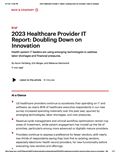
In their second annual report, Bain & Company and KLAS Research explore the trends impacting the Healthcare IT market.

Provider organizations are facing workforce shortages and financial instability. care.ai aims to help organizations with these challenges via their Smart Patient Rooms product, which is virtual care hardware that supports healthcare staff with virtual nursing, monitoring, and predictive analysis powered by AI. This report offers an early look at care.ai’s customer experience.

Remote patient monitoring (RPM) solutions have grown in adoption, giving providers new ways to acquire, store, transmit, and display electronic health information from patients outside of conventional clinical settings—most often their homes. This report details customer experiences with CareSignal’s deviceless RPM offering—using texts and phone calls to gather data rather than RPM hardware.
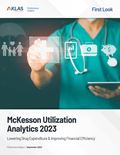
Healthcare in the US is uniquely inefficient, with costs generally growing faster than the overall economy. Consequently, lowering drug expenditure and improving financial efficiency are pivotal for health systems. To help customers maximize cost savings and discover revenue opportunities, McKesson’s Utilization Analytics solution integrates with drug purchasing, usage, patient administration, and reimbursement data as opposed to theoretical usage and payer contracts. This report offers a first look at customer experiences with this solution.
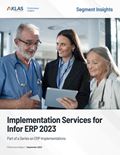
Many provider organizations are adopting new cloud-based ERP solutions, but implementing an ERP solution is a big undertaking that can affect day-to-day business. Due to the breadth of areas ERP touches as well as post-COVID-19 staffing challenges, organizations are engaging firms that offer implementation leadership and business transformation services. This report examines client experiences with firms who provide implementation services for Infor’s ERP suite. (Engagements for implementing other vendors’ ERP solutions are excluded from this research. In early 2023, KLAS published ; KLAS also plans to publish future research on firms that implement Oracle’s ERP software.)

Revenue cycle management (RCM) is a complex process that requires healthcare organizations to continually adapt to ever-changing market conditions, regulations, and patient expectations. Healthrise aims to meet the evolving needs of healthcare organizations by providing IT services for EMR go-lives, revenue cycle optimization, and HIT staffing. This report offers a first look at client experiences with Healthrise.

Competitive and financial factors continue to drive organizations toward value-based care. A widely varied array of services firms and other vendors offer services and solutions designed to help. This report details CareAllies’ value-based care managed services offering and examines client experiences.

Many employers recognize that keeping employees healthy is vital to a company’s success. Providing employer-sponsored healthcare services ensures staff members have easy access to the healthcare they need. Proactive MD aims to support employers who want to offer these services by providing fully encompassed and managed healthcare services. This report examines the experiences of client organizations using Proactive MD’s services.

In December 2022, Omnicell announced a change in their approach to working with customers that places new emphasis on having customers utilize a managed services model for all Omnicell technology. Previously, Omnicell moved singular solutions (namely their compounding robots, such as the i.v.STATION) to a managed services model, and with those changes, customers generally noted an improved experience, even with increased costs. Given the economic conditions and staffing challenges currently impacting healthcare, many customers have concerns about how Omnicell’s new focus will impact things like costs, product deployment, and staffing demands. This report provides an early look into customer confidence in and perception of the new managed services model.

Over the last several years, social determinants of health (SDOH) have become an emerging focus for healthcare organizations. Even with growing interest, progress toward a standardized SDOH program has been challenging for many provider organizations and their communities. In March 2023, KLAS held the Social Determinants of Health Summit, where 69 leaders from 61 organizations that have made early progress in SDOH programs shared feedback—with the goal of building a cohesive framework for organizations standing up SDOH programs in their communities. Participants at the summit included representatives from provider organizations, payers, HIT vendors, and community-based organizations (CBOs). In addition to the creation of the SDOH framework, the summit included two panels that focused on financing SDOH and on helpful metrics for tracking the impact of SDOH. This summit executive overview presents the finalized SDOH framework, summit participant insights, and highlights from the two panel discussions on financing and impact tracking.

Purchasing drugs that provide the best value is important for any healthcare system’s financial well-being but can also be difficult and time consuming without the right tools. Verity Solutions’ Verisave aims to replace the manual selection process by automatically selecting—in real time—the best-priced products before orders are placed. This report offers a first look at the Verisave customer experience.

Facing unprecedented staffing and financial challenges in an ever-changing HIT landscape, provider organizations have a critical need for proactive support and guidance from vendors. While KLAS data shows that most customers are generally satisfied with their vendor’s proactive service, roughly one-third are dissatisfied. This report highlights where proactive service failings occur, the impact of not proactively serving customers, and ways both provider organizations and vendors can better partner to get the most out of technology.

Due to staffing shortages and increased labor costs, many healthcare organizations are outsourcing revenue cycle work to external firms. ECLAT Health Solutions offers a broad outsourcing solution set that allows healthcare provider and payer clients to offload various aspects of revenue cycle management, including facility coding, ProFee coding, HCC coding, A/R and denials management, and patient access call center services. This report examines clients’ experiences and satisfaction with ECLAT.

Patients that require frequent monitoring or sitting can quickly put a strain on healthcare organizations’ staff. AvaSure seeks to reduce this burden with their all-in-one virtual sitting platform, supplying both hardware and software that allows one person to monitor and communicate with multiple patients in real time. , and this report offers a second look at how the customer experience has changed over the last two years.

Despite the healthcare industry’s progress with interoperability (HIEs, national record exchanges, Direct Secure Messaging, APIs), healthcare organizations still heavily rely on faxing to exchange data. Faxing technology has evolved to accommodate fully digital processes, but provider organizations are looking for next-generation faxing functionality—like optical character recognition (OCR) and natural language processing (NLP)—to further automate workflows. Drawing from interviews with organizations identified by vendors as their most advanced users, this report follows up on KLAS’ and validates what next-generation functionality vendors have deployed. It also shares market insights into the organizational effort required to maintain digital faxing and the future viability of digital faxing in healthcare.

For healthcare organizations, the outbreak of the COVID-19 pandemic underscored the importance of having a holistic and integrated solution for safety, risk, and compliance management. Purchase energy in this market is increasing as more organizations are looking for solutions to increase visibility into safety events and compliance, address potential risks, and enhance patient and staff safety. To better understand what factors are influencing purchase decisions and which vendors are seeing the most traction, this report examines 51 recent purchase decisions validated by KLAS between May 2021 and May 2023. For additional context, some satisfaction data from current customers is also included.

To ensure success, any healthcare organization needs to maintain positive patient-provider relationships. Solv. Health aims to provide an easy-to-use tool set for building and keeping those relationships. This report provides a first look at customers’ experiences using Solv.

The recent surge of artificial intelligence (AI) and machine learning (ML) has created opportunities for technology-based efficiencies in healthcare. Regard’s solution is an EHR-embedded AI co-pilot for clinicians that uses patient data to suggest new diagnoses and automatically generate clinical notes directly in the clinician workflow. This report offers a look at customers’ experiences and satisfaction with the Regard solution.

In recent years, the complex payer claims and administration market has seen several changes. Historically, payers have used multiple technology vendors and homegrown tools to meet their broad functionality needs. Now, payers are looking to consolidate platforms to improve efficiency and their ability to manage multiple business lines. As finding a platform that meets payers’ complex needs can be challenging, this report provides a comprehensive look at which business lines vendors are focused on, which vendors are gaining or losing market considerations, and how satisfied customers are with their platforms.

As patient payment responsibility increases, equitable access to healthcare is becoming more difficult, adding financial stress to patients and straining healthcare organizations with declining cash flows. PayZen seeks to address these issues. Their automated, AI-driven platform integrates with existing revenue cycle systems and provides patients with personalized payment options. Simultaneously, PayZen funds providers upfront, reducing cash flow concerns and administrative burden. This report examines customers’ experiences.

Gaps in the revenue cycle process cost healthcare organizations billions of dollars every year. SmarterDx aims to help organizations boost revenue with their AI solution, which serves as a checkpoint that scans charts before billing and helps organizations ensure no opportunities are lost. This report examines the SmarterDx customer experience.

The term “digital front door” has become popular in recent years across the healthcare industry. Increasingly, it is used to refer to patient interactions not only before visits but also during and after care. The Health Management Academy and KLAS Research have partnered to create this guide, aimed at helping healthcare organizations understand the market as a whole and their vendor options.

To enhance efficiency and system reliability, healthcare organizations need robust tools that monitor their IT system. With system optimization, organizations can deliver higher-quality care, improve patient access to medical records, improve response times, and offer better healthcare services overall. Goliath Technologies aims to help organizations’ IT infrastructure perform optimally by offering comprehensive system performance-monitoring tools. This report examines the customer experience of Goliath Technologies.

Healthcare organizations need effective patient-provider communication and engagement solutions. Nuance Patient Engagement Solutions (PES) aims to increase patient engagement and improve the consumer experience through omnichannel engagement technology and intelligently automated personalized interactions. Additionally, the software can help facilitate better patient interactions through integration with core systems (e.g., EHR, revenue cycle, and CRM solutions). This report offers a first look at customer experiences with Nuance PES.

SKYGEN aims to transform benefits management and administration for specialty payers to reduce costs and increase satisfaction for all involved. Currently focused on dental and vision payers, SKYGEN offers a variety of technology to fill all common core administration needs. All solutions are available as a SaaS platform or through SKYGEN’s third-party administrator (TPA) model. This report examines the SKYGEN customer experience.

Healthcare organizations face more operational challenges now than ever, so they are looking to a variety of sources to overcome barriers. Vendors of multiple solution types have an opportunity to improve their offerings to better help healthcare organizations tackle top operational challenges. For this report, KLAS spoke to 51 healthcare executives from 51 organizations to examine current operational strategies, goals, and perceived challenges as well as the role that technology plays in addressing these challenges.

is a key area that helps healthcare organizations improve patient safety and prevent drug waste and misuse. The second generation of drug diversion monitoring solutions utilizes predictive models, artificial intelligence (AI), and machine learning (ML), and users are beginning to see outcomes such as correctly identified risks, reduced false positives, and increased efficiency. This report examines which vendors are driving outcomes, how advanced AI/ML capabilities are impacting the user experience, and how well vendors partner with and support customers.

The virtual patient observation market is growing due to increasing demand for virtual inpatient observation services. Healthcare organizations are looking for ways to reduce staffing burden, increase efficiency, decrease costs, and improve patient safety. MedSitter’s virtual patient observation solution aims to meet these customer needs. This report offers an initial look at customers’ experiences with MedSitter.

By preventing and detecting unauthorized access to patient data, patient privacy monitoring solutions play an integral role in helping provider organizations maintain patient confidentiality, comply with regulations, and build trust. In recent years, the market has seen multiple acquisitions, and vendors have begun to provide artificial intelligence (AI) offerings. This report looks at how these changes have affected customer satisfaction and provides early insights on outcomes related to AI.

When making a core HIT purchasing decision, healthcare organizations must take into account how prospective partners deliver across a variety of key technology areas. This Epic “complete look” provides a high-level analysis of the key products that make up Epic’s enterprise suite. (Other reports in the series do the same for .)

When making a core HIT purchasing decision, healthcare organizations must take into account how prospective partners deliver across a variety of key technology areas. This Evident (CPSI) “complete look” provides a high-level analysis of the key products that make up Evident’s core enterprise suite and its supporting technology. (Other reports in the series do the same for .)

When making a core HIT purchasing decision, healthcare organizations must take into account how prospective partners deliver across a variety of key technology areas. This MEDITECH Expanse “complete look” provides a high-level analysis of the key products that make up MEDITECH’s enterprise suite. (Other reports in the series do the same for .) This report focuses on the core Expanse suite; data on MEDITECH’s MAGIC, C/S, and 6.x platforms is excluded.

When making a core HIT purchasing decision, healthcare organizations must take into account how prospective partners deliver across a variety of key technology areas. This Oracle Health (Cerner) “complete look” provides a high-level analysis of the key products that make up Oracle Health’s enterprise suite. (Other reports in the series do the same for .)

When making a core HIT purchasing decision, healthcare organizations must take into account how prospective partners deliver across a variety of key technology areas. This Altera Digital Health (Allscripts) Sunrise “complete look” provides a high-level analysis of the key products that make up Altera Digital Health’s enterprise suite. (Other reports in the series do the same for .) This report focuses on the core Sunrise suite and its supporting technology; data on Altera Digital Health’s standalone ambulatory platforms (TouchWorks and Professional) is excluded.

Healthcare organizations face a variety of challenges, including staffing shortages, EHR implementations, and enhancement and modernization of other processes and solutions. Brightwork Health IT provides services to help organizations with staff augmentation, infrastructure modernization, revenue cycle enhancement, and Epic implementations. This report details the experience of Brightwork clients and their satisfaction with the firm’s services.

Amid the pressures of today’s economic environment, healthcare organizations are investing heavily in patient engagement technology to help reduce costs, alleviate staffing challenges, and consolidate technology in other areas. Both provider and payer organizations seek to understand what patient engagement capabilities vendors offer that can meet their core needs. This study (along with additional deep-dive content that will be published on KLAS’ website) is an update to accompanied by a limited amount of KLAS performance data.

Payers, providers, and patients all win when payer and healthcare organizations form collaborative, trusting partnerships. While such relationships can be difficult to achieve, KLAS has seen collaborations between payers, providers, and technology vendors yield outcomes that are meaningful to all parties. With the aim of accelerating these efforts, KLAS hosted the third annual K2 Collaborative Summit in May 2023. It was attended by 96 leaders from 84 payer, provider, and HIT vendor organizations across the healthcare industry.

Healthcare organizations are connecting more and more devices to their networks to enable seamless communication and enhance patient care, but the increase in devices also increases security risks that can expose important data and jeopardize patient safety. Many organizations use IoT security solutions to gain visibility into potential vulnerabilities, and some are engaging with their vendors to tackle broader cybersecurity strategies. To provide insights into the competitive healthcare IoT security market, this report looks at vendor performance amid recent mergers/acquisitions as well as early insights into how vendors meet the needs of deep adopters.

The landscape of pediatric healthcare has shifted in recent years. Grappling with changes in the labor market, many pediatric organizations are seeking out a simplified IT approach that enhances patient care and bolsters efficiency. Some organizations have started to consolidate or have already consolidated their technology stack to fewer vendors, with many leveraging more functionality from their core EHR vendors. For this report, KLAS talked to 57 organizations using pediatric EHR/PM systems to gauge their perceptions on the impact of staffing shortages, which technology is best suited to help, and what developments they would like moving forward. A follow-up report will examine the performance of pediatric EHR/PM vendors within this evolving market.

Telehealth and remote patient monitoring (RPM) solutions have grown in adoption, giving providers new ways to deliver more flexible care. While telehealth adoption especially was initially spurred by COVID-19, energy in both areas continues because of factors like value-based care, staffing shortages, and the desire to make care delivery more flexible and strategic. This report examines the broad ecosystem of telehealth and RPM technology—specifically, breadth and depth of adoption by their provider organization customers.

In recent years, physician scheduling vendors have made great strides in providing scheduling solutions that drive tangible outcomes for provider organizations. This report takes a first look at the customer experience with and overall performance of TigerConnect’s Physician Scheduling solution (formerly Call Scheduler).

Given the staffing challenges that persist in today’s healthcare market, provider organizations want tools that generate new business and alleviate their scheduling burden. Additionally, a top priority for patients today is the ability to self-schedule online. Zocdoc aims to meet the current needs of both provider organizations and patients through a cloud-based booking platform. This report examines customer experience and satisfaction with Zocdoc’s platform.

With increasing demand for better healthcare services, organizations need ways to improve a major pain point along the care journey: patient scheduling. Organizations need solutions that improve patient outcomes, increase efficiency, and streamline workflows. Patients want an improved experience through timely, convenient access to care. Relatient Dash Schedule aims to meet the scheduling needs of both patients and organizations, and this report offers a first look at provider customers’ experiences.

Organizations using behavioral health EHRs report some of the lowest satisfaction scores of any KLAS-measured market segment. Healthcare organizations are eager to find solutions that meet their needs and the needs of their patients. This report offers a first look at customers’ experiences with Qualifacts’ InSync Behavioral Health EHR.

The transition to value-based care has increased the need for accurate intelligence and documentation. Organizations also need solutions that drive clinical and financial outcomes amid clinician burnout, understaffing, and stretched financial resources. Through their AI-powered workflow solution, Navina aims to address these market challenges by restructuring disorganized data into an intuitive patient portrait. This report evaluates customers’ experiences with Navina.
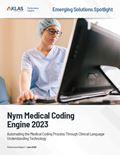
Interest in autonomous coding solutions is growing as healthcare organizations seek to ease staffing shortages and improve revenue cycle performance. Automated coding simplifies workflows and saves provider organizations time and money. Nym aims to meet market needs by providing a medical coding engine that accurately interprets clinical language and brings automation, speed, and accuracy to the medical billing process. This report offers a look at executive experiences from large-hospital health systems that are using Nym’s medical coding engine.

As digital pathology for primary diagnosis expands across the world, artificial intelligence (AI) promises to drive key benefits from digital transformation—the primary benefits being increased diagnostic accuracy and pathologist efficiency. Ibex Medical Analytics’ Galen suite of AI solutions provides algorithms to assist pathologists with the identification and grading of cancer regions as well as provides various other decision support tools in digital pathology. This report validates customers’ experiences with this program.

Growth in the healthcare industry is frequently accompanied by mergers and acquisitions—often between organizations with distinct technological fingerprints. To save money and improve interoperability, it is crucial for the newly united entity to consolidate software systems as soon as possible. Divurgent’s M&A HIT services provide resources and guidance intended to make the transition as smooth as possible and ultimately drive financial savings.

It can be challenging for healthcare organizations to provide timely access to quality behavioral healthcare across the continuum of care. This can result in patient and provider dissatisfaction and poor patient outcomes. Iris Telehealth seeks to address these challenges with their care models backed by a Joint Commission accredited behavioral health medical group. This report examines the experience of clients who utilize Iris Telehealth on a large scale across their organization.

Margins are tight for many healthcare organizations due to factors like inflation, high costs for labor and materials, fewer high-margin procedures, and staffing shortages. As a result, the demand for automated workflows is growing. This report is KLAS’ first comprehensive look at ServiceNow, a cross-industry vendor that offers automated workflows. Drawing from 17 healthcare organizations’ insights, the following pages share how ServiceNow is being used and what the customer experience is like.

Amid the healthcare industry’s ongoing staffing shortages, many healthcare organizations are turning to external firms for outsourced coding services. These firms can provide valuable coding expertise and help control coding-related costs. This report aims to help organizations choose the right firm for their needs—detailing firms’ ability to deliver value, exceed client expectations, maintain consistent staff and high coding quality, and partner with their clients.

Qventus Solutions aims to help healthcare organizations create and sustain operational improvements related to patient throughput and capacity optimization management. Qventus addresses operational issues and opportunities through automation, AI/machine learning (ML), and predictive analytics. Depending on organizational needs, the Qventus system can be implemented in perioperative, inpatient, emergency department, and/or command center settings. This report examines customers’ experiences and satisfaction with Qventus.

The complexity of benefits administration can draw focus away from improving health and wellness opportunities for health plan participants. Viveka Health’s benefits administration solution aims to help by integrating all functionality required to administer benefits into one comprehensive platform, allowing payers to communicate, manage claims, and analyze data all in one place. This report explores the experiences of six unique Viveka Health customers and their satisfaction with the platform.

As more healthcare organizations start to leverage population health management (PHM) technology in their journey toward offering value-based care, they are sometimes uncertain about how well vendors can fulfill their unique needs, as PHM programs vary in breadth and complexity. This report—a follow-up to

In response to the high and variable costs of local health care providers and the challenges associated with finding timely access to quality care, many employers (public and private) and unions are offering health centers on-site, near-site, or shared with nearby companies to better address the health care needs of covered employees and their dependents. This report is a collaborative effort by KLAS Research and the National Association of Worksite Health Centers (NAWHC) aimed at offering guidance on the essential factors to consider when selecting a vendor to manage a worksite center. This guidance is applicable even when a third-party agency, such as a broker, is involved in the process. Best practices below come from KLAS and NAWHC research, including insights from employers and unions who have implemented health centers.

For many healthcare organizations, the need to improve clinician satisfaction and effectiveness is top of mind. To help with that goal, those using clinical documentation integrity (CDI) solutions are looking to their vendor partners for innovation to aid in increased documentation efficiencies. This report provides a look at the performance of CDI vendors, focusing on key elements that drive customer satisfaction such as vendor relationships, driven outcomes, and reporting capabilities.

Healthcare organizations are constantly looking for ways to improve productivity and achieve greater financial outcomes, and gamification is a recent trend that can help organizations gain better efficiency. athenahealth Gamify infuses game concepts and a rewards system into daily tasks with the objective of improving productivity. This case study examines early feedback from the two customers who are live with athenahealth Gamify.

By building and administering their own specialty pharmacy programs, US hospitals and health systems can increase revenue and improve clinical outcomes. Clearway Health aims to provide needed expertise and resources to enable any hospital organization to build and run a specialty pharmacy program. This report offers a first look at the experiences of clients who have engaged these services from Clearway Health.

With the pandemic mostly past, healthcare organizations across the world are readdressing key technology priorities. EMR initiatives continue to be prioritized at most organizations. In 2022, KLAS validated 164 EMR purchase decisions impacting 532 hospitals and over 82,000 beds. 30 different vendors in 31 different countries were selected. While 2022 had the lowest validated EMR purchase activity of the last five years, certain markets remained highly active—specifically, Europe and Latin America and, to a lesser extent, Asia and the Middle East. Canada and Oceania, while relatively quiet in 2022, are poised for significant activity in 2023 due to major contracts on the horizon.

shows that clinical communication platforms can improve healthcare organizations’ efficiency and care quality when successfully adopted across the enterprise. Vendors can help drive strong adoption—in number of workflows/interfaces deployed, in breadth (percentage of an organization’s hospitals that adopt the solution), and in depth (percentage of employees using the solution). This report examines these factors and shares how well vendors enable adoption and support organizations’ communication strategies.

The market for both medical and radiation oncology EMRs is shifting. For medical oncology, many previously independent oncology practices and cancer centers have been consolidated into larger health systems, leading to the adoption of medical oncology modules from acute care EMR vendors—a trend that is set to continue. Additionally, customer satisfaction in the radiation oncology market has shifted in recent years as the two primary vendors have competed for each other’s customers. Leveraging the perspectives of 158 organizations, this report explores the performance of medical and radiation oncology EMR vendors to see which are meeting customer needs and which are falling behind.

Remote patient monitoring (RPM) has demonstrated promising outcomes

EMR purchasing continued at a strong pace in 2022 and included a significant uptick in migrations and small-organization decisions. Improvements to clinician satisfaction, interoperability, and revenue cycle stability were the primary drivers. This report examines these and other trends in EMR purchases that occurred in the US January–December 2022.

Amid staffing challenges and revenue shortfalls, healthcare organizations feel pressure to provide documentation strategies that cut costs by increasing automation while still maintaining high accuracy. Computer-assisted coding (CAC) solutions are one strategy used to meet those needs. This report explores customer perceptions of CAC vendors’ support and service and their solutions’ ability to be accurate, perform well across departments, and improve coder productivity.
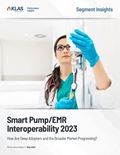
Healthcare organizations are increasingly investing in bidirectional interoperability between smart pumps and EMR solutions to improve patient safety and nursing efficiency. This report provides a market snapshot of which smart pump vendors offer this interoperability to customers. Additionally, this report examines the experiences of deep adopters in order to gain insight into the outcomes and vendor guidance they receive.

HIT vendors consistently strive to live up to their customers’ expectations, and KLAS data shows that most vendors successfully keep all their promises. But in the last year, one in four healthcare organizations interviewed by KLAS report their vendor does not keep all promises. This report highlights where broken promises most often occur, the impact of broken promises on provider organizations, and how both organizations and vendors can ensure promises are kept, fostering better vendor/client trust and ultimately better patient care.

The digital transformation of healthcare has innovated the way patients receive care; this is especially evident in the emergence of digital patient rooms, which use technology to improve personalization, accuracy, and overall experience for patients and providers within the hospital. When properly developed, these digital patient rooms can also ease the staffing challenges many healthcare organizations face today. While vendors in the interactive patient systems space have traditionally focused on and still provide education and entertainment technology in the patient room, this report focuses on advanced digital patient room capabilities offered by these vendors by examining (1) which solutions have the broadest adoption across these advanced capabilities, (2) which solutions are viewed as most complete, and (3) what outcomes deep adopters are achieving.

Over time, care management vendors have developed new functionalities that have allowed payer organizations to move beyond traditional use cases (e.g., case management and utilization management) into emerging use cases (e.g., behavioral health, automated prior authorization). Care management solutions are in an already low-performing market with persistent integration and functionality challenges, and with these emerging use cases, customers have a renewed need for strong engagement and support from vendors. This report examines which vendors are providing strong customer relationships, delivering innovative product functionality, and facilitating adoption and long-term customer loyalty.

Allowing organizations to archive and access historical data from retired legacy software, data archiving solutions continue to be in high demand. This report takes a first look at the customer experience with Olah Enterprise Archiving Solution, the solution’s performance in a variety of use cases, and key functionality adoption among customers.

Resource-strapped hospice leaders are looking for tools that alleviate clinician burnout by streamlining workflows and building additional point-of-care functionality. Slow vendor development on this front has led to an overall decline in customer satisfaction. This report dives into how well hospice vendors meet provider organizations’ needs, including delivery of value, development progress, and support for when patients go through a transition of care.

In today’s healthcare market, patient engagement tools are in high demand. Steer Health’s patient experience and growth platform aims to orchestrate digital patient journeys across all stages of care for personalized and automated digital patient experiences. The product’s intended outcomes include driving practice growth and improving patient satisfaction. This report examines the experiences of early adopters of the Steer Health platform.

Operational limitations—such as staffing shortages, variable patient flow, and poor visibility into resource availability—can make it difficult for healthcare organizations to effectively manage their capacity, leading to volatile workloads that see resources either under- or overutilized. Some organizations are using capacity optimization management technology, which includes artificial intelligence (AI) and machine learning (ML), to collect data that can improve resource management, especially regarding the utilization of scarce assets like operating rooms, inpatient beds, and infusion centers. This report—KLAS’ first to focus on capacity optimization management—shares what technology is being used and what outcomes it is driving for customers.

